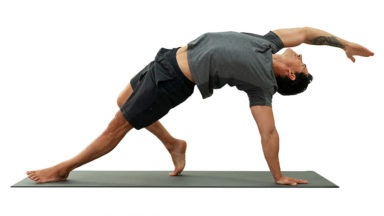Ardha Matsyendrasana: Half Lord of the Fishes Pose

ADJUSTMENTS | BENEFITS | SEQUENCING | SANSKRIT | STEPS
Ardha matsyendrasana (ARE-dah MOT-see-en-DRAHS-ah-nah) is an approachable twist that opens the shoulders and chest. A good antidote for too much sitting and symptoms that come with overusing technology, half lord of the fishes pose has the ability to increase energy in the body while also stoking the digestive fire in your belly.
Philosophy + Origin
Matsyendra is often recognized as one of the original founders of hatha yoga in yogic mythology. He was said to be a baby who was thrown into the ocean after his parents rejected him. The story of Matsyendra reminds us that it’s often the parts of our personal stories we don’t like or don’t want to accept that can be the most beneficial, especially on the path to becoming a yogi or yogini. Rather than conceptualizing the twist to be a purge of what is unwanted or unnecessary, think of the detoxification as a purification, an opportunity to take what was once viewed or understood as “bad” and transform it into something that is helpful on your personal journey.
ADJUSTMENTS/MODIFICATIONS:
- Place a folded blanket under your hips to create space to lengthen the spine.
- Option to extend the bottom leg forward rather than bending. This is a great variation for tender knees.
- Option to hug the bent knee rather than bringing the upper outer arm outside the opposite thigh.
- Option to bind the arms by clasping the hands behind your back.
STEP-BY-STEP:
- Begin seated on your mat with both legs extended out in front of you (dandasana). Bend your right knee and step your foot to the outside of your left leg. Stay here, or bend your left knee so your left foot is next to your opposite hip.
- Place your right hand to the ground (or a block) behind your hips. Inhale to lift your left arm high, exhale to twist to the right and hook your left elbow outside your right thigh.
- Root down through your sitting bones and lift through the crown of your head. On every exhale, invite a gentle twist to the right.
- Option to take your gaze over your right shoulder.
- Hold for 5 breaths then release back to center. Pause in a seated shape for a few breaths, then repeat on the other side.
PREPARATORY POSES:
- Two knee spinal twist | Jathara parivartanasana
- Revolved childs pose | Parsva balasana
- Head to knee pose | Janu sirsasana
SEQUENTIAL POSES:
- Baby grasshopper pose
- Cow face pose | Gomukhasana
COUNTER POSES:
- Seated forward fold | Paschimottanasana
- Bound angle pose | Baddha konasana
SANSKRIT:
- Ardha = Half
- Matsya = Fish
- Indra = Ruler
- Asana = Pose
PHYSICAL BENEFITS:
- Increases flexibility and range of motion in the spine.
- Opens chest and shoulders.
- Can relieve tension in thoracic (mid) spine.
- Stimulates agni, the digestive fire in the body.
Legal Disclaimer Before participating in any exercise program or using any fitness products or services that may be described and/or made accessible in or through the Gaia Website and/or the Services, you should consult with a physician or other healthcare provider. Read more about Gaia’s Terms Of Use.
Phalakasana: Plank Pose

ADJUSTMENTS | BENEFITS | SEQUENCING | SANSKRIT | STEPS
Phalakasana (fall-ack-AHS-anna), is an essential posture for a strong yoga practice. Holding plank pose will improve your endurance and muscle tone, help develop the strength needed for more complex poses, and generate heat and stimulating the navel chakra.
Philosophy + Origin
Hidden in the pose’s name is the Sanskrit word “phala,” which means to bear fruit or ripen. In yoga, the idea of tapas, often translated as “heat,” “passion,” or “discipline,” fuels the physical asana practice, encouraging students to seek out the challenge again and again in order to become stronger, to build an internal flame in the body that fuels every aspect of life. When you think of plank pose as an opportunity to “ripen” or “bear fruit,” you become aware of the transformative effect of this seemingly simple (although challenging) pose. Each time you enter the pose, use the breath to ripen the fruit of your labors. The ability to hold this pose with steadiness and grace is known to create major shifts in your practice and your life.





































